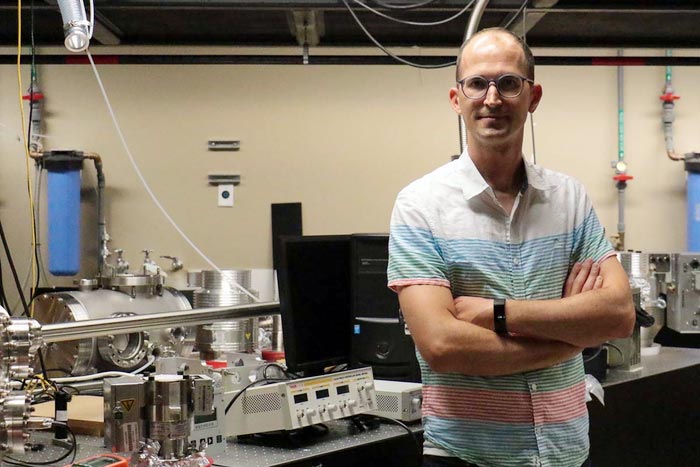UCF develops the world’s first optical oscilloscope

UCF Physics Associate Professor Michael Chini worked on the world’s first optical oscilloscope.
Credit: University of Central Florida
The innovation could be a game-changer for communication technologies, such as phones and internet connections.
A team from UCF has developed the world’s first optical oscilloscope, an instrument that is able to measure the electric field of light. The device converts light oscillations into electrical signals, much like hospital monitorsconvert a patient’s heartbeat into electrical oscillation.
Until now, reading the electric field of light has been a challengebecause of the high speeds at which light waves oscillates. The most advanced techniques, which power our phone and internet communications, can currently clock electric fields at up to gigahertz frequencies — covering the radio frequency and microwave regions of the electromagnetic spectrum. Light waves oscillate at much higher rates, allowing a higher density of information to be transmitted. However, the current tools for measuring light fields could resolve only an average signal associated with a ‘pulse’ of light, and not the peaks and valleys within the pulse. Measuring those peaks and valleys within a single pulse is important because it is in that space that information can be packed and delivered.
“Fiber optic communications have taken advantage of light to make things faster, but we are still functionally limited by the speed of the oscilloscope,” says Physics Associate Professor Michael Chini, who worked on the research at UCF. “Our optical oscilloscope may be able to increase that speed by a factor of about 10,000.”
The team’s findings are published in this week’s Nature Photonics journal.
The team developed the device and demonstrated its capability for real-time measurement of the electric fields of individual laser pulses in Chini’s lab at UCF. The next step for the team is to see how far they can push the speed limits of the technique.
The lead author of the paper is UCF postdoctoral scholar Yangyang Liu. Other authors include physics alums Jonathan Nesper ’19 ’21MS, who earned his bachelor’s in math and master’s in physics; Shima Gholam-Mirzaei ’18MS ’20PhD; and John E. Beetar ’15 ’17MS ’20PhD.
Gholam-Mirzaei is now a postdoctoral researcher at the Joint Attosecond Science Laboratory at the National Research Council of Canada and University of Ottawa and Beetar is completing a postdoc at the University of California at Berkeley.
Chini had the idea for the single-shot waveform measurement scheme and oversaw the research team. Liu led the experimental effort and performed most of the measurements and simulations. Beetar assisted with the measurements of the carrier-envelope phase dependence. Nesper and Gholam-Mirzaei assisted with the construction of the experimental setup and with the data collection. All authors contributed to the data analysis and wrote the journal article.
The work was supported primarily through a grant from the Air Force Office of Scientific Research under Award No. FA9550-20-1-0284, while Gholam-Mirzaei was supported by the Army Research Office under Award No. W911NF-19-1-0211.
Journal: Nature Photonics
DOI: 10.1038/s41566-021-00924-6
Article Title: Single-shot measurement of few-cycle optical waveforms on a chip
Article Publication Date: 13-Dec-2021
Media Contact
Robert Wells
University of Central Florida
robert.wells@ucf.edu
Office: 352-213-5481
All latest news from the category: Information Technology
Here you can find a summary of innovations in the fields of information and data processing and up-to-date developments on IT equipment and hardware.
This area covers topics such as IT services, IT architectures, IT management and telecommunications.
Newest articles

Innovative 3D printed scaffolds offer new hope for bone healing
Researchers at the Institute for Bioengineering of Catalonia have developed novel 3D printed PLA-CaP scaffolds that promote blood vessel formation, ensuring better healing and regeneration of bone tissue. Bone is…

The surprising role of gut infection in Alzheimer’s disease
ASU- and Banner Alzheimer’s Institute-led study implicates link between a common virus and the disease, which travels from the gut to the brain and may be a target for antiviral…

Molecular gardening: New enzymes discovered for protein modification pruning
How deubiquitinases USP53 and USP54 cleave long polyubiquitin chains and how the former is linked to liver disease in children. Deubiquitinases (DUBs) are enzymes used by cells to trim protein…



